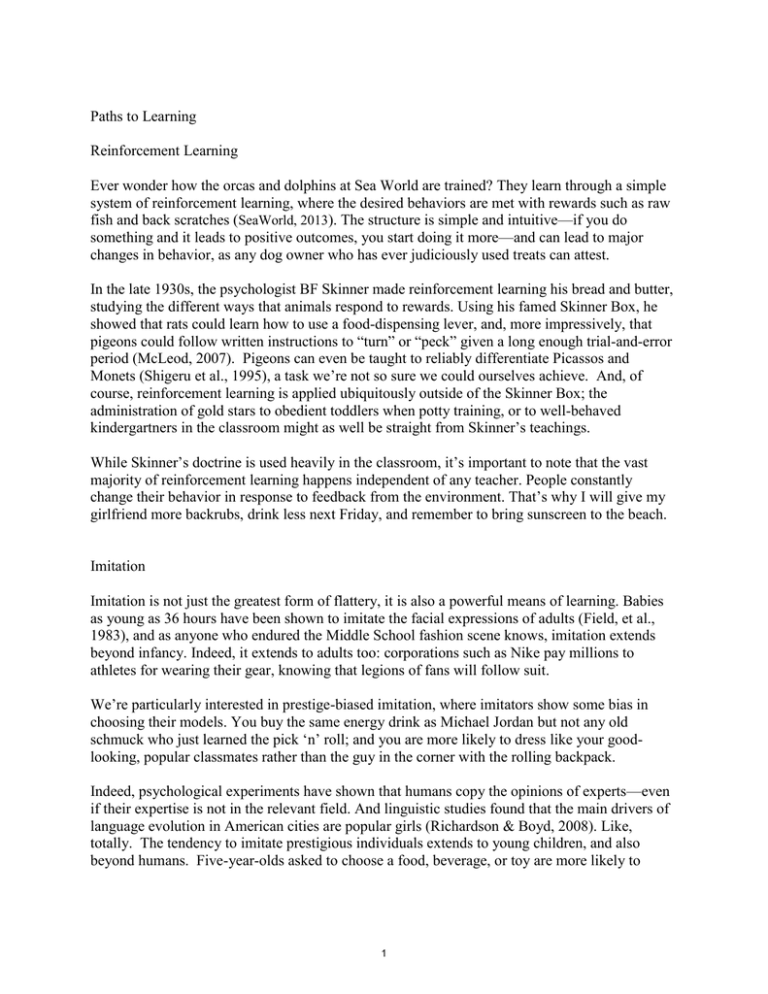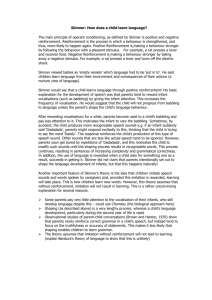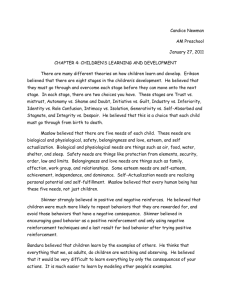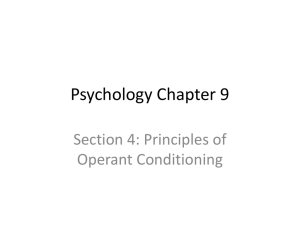Paths to Learning Reinforcement Learning
advertisement

Paths to Learning Reinforcement Learning Ever wonder how the orcas and dolphins at Sea World are trained? They learn through a simple system of reinforcement learning, where the desired behaviors are met with rewards such as raw fish and back scratches (SeaWorld, 2013). The structure is simple and intuitive—if you do something and it leads to positive outcomes, you start doing it more—and can lead to major changes in behavior, as any dog owner who has ever judiciously used treats can attest. In the late 1930s, the psychologist BF Skinner made reinforcement learning his bread and butter, studying the different ways that animals respond to rewards. Using his famed Skinner Box, he showed that rats could learn how to use a food-dispensing lever, and, more impressively, that pigeons could follow written instructions to “turn” or “peck” given a long enough trial-and-error period (McLeod, 2007). Pigeons can even be taught to reliably differentiate Picassos and Monets (Shigeru et al., 1995), a task we’re not so sure we could ourselves achieve. And, of course, reinforcement learning is applied ubiquitously outside of the Skinner Box; the administration of gold stars to obedient toddlers when potty training, or to well-behaved kindergartners in the classroom might as well be straight from Skinner’s teachings. While Skinner’s doctrine is used heavily in the classroom, it’s important to note that the vast majority of reinforcement learning happens independent of any teacher. People constantly change their behavior in response to feedback from the environment. That’s why I will give my girlfriend more backrubs, drink less next Friday, and remember to bring sunscreen to the beach. Imitation Imitation is not just the greatest form of flattery, it is also a powerful means of learning. Babies as young as 36 hours have been shown to imitate the facial expressions of adults (Field, et al., 1983), and as anyone who endured the Middle School fashion scene knows, imitation extends beyond infancy. Indeed, it extends to adults too: corporations such as Nike pay millions to athletes for wearing their gear, knowing that legions of fans will follow suit. We’re particularly interested in prestige-biased imitation, where imitators show some bias in choosing their models. You buy the same energy drink as Michael Jordan but not any old schmuck who just learned the pick ‘n’ roll; and you are more likely to dress like your goodlooking, popular classmates rather than the guy in the corner with the rolling backpack. Indeed, psychological experiments have shown that humans copy the opinions of experts—even if their expertise is not in the relevant field. And linguistic studies found that the main drivers of language evolution in American cities are popular girls (Richardson & Boyd, 2008). Like, totally. The tendency to imitate prestigious individuals extends to young children, and also beyond humans. Five-year-olds asked to choose a food, beverage, or toy are more likely to 1 choose one they saw chosen by an individual who has received social recognition (Chudek et al., 2011), and chimpanzees preferentially imitate older, higher-ranking individuals (Horner, 2010). Forgetting About Function Learning doesn’t always lead to functional behaviors. Sometimes it leads to superfluous ones. For instance, many people still “knock on wood” despite numerous studies demonstrating the futility of the tactic.1 Fortunately, however, learning is often functional. Perhaps you learned, through reinforcement, to cover your mouth when you burp, or, through imitation, how to tie your shoes. And if that failed, then through reinforcement, to buy loafers. In the cases above, and especially during explicit teaching, you likely knew the function of the acquired skill. But—and this is important—sometimes you don’t. Let’s say someone has told you that to keep the gods happy, you should hold chicken over fire for a while before you eat it. You engage in this ritual, and shortly thereafter cease contracting poultry-related illnesses, thus reinforcing the behavior. You have adopted a functional practice under the guise of pleasing fireloving gods, and with no understanding of the true mechanism behind the action’s efficacy. Similarly, let’s say my religion prohibits oranges and yours outlaws crab. A prestige-minded imitator would take note of my scurvy-ridden disciples and likely avoid it. Your parish, on the other hand, devoid of seafood-borne parasites, would flourish, as people wisely copy healthylooking people. A functional practice would arise solely due to superstition and prestige-based imitation. In a study on a Fijian tribe, Joseph and Natalie Henrich (2010) found that the Fijians adopted the functional practice of avoiding dangerous foods with no knowledge that these foods were more poisonous. Only a tiny fraction of the Fijians learned about the taboos from medical professionals—most learned them from their mothers, grandmothers, or aunts. And nearly all the Fijians the Henrichs surveyed said adhered to the taboos to avoid the wrath of the gods, which, in fairness, sounds a lot scarier than some measly germs. But in end, it doesn’t matter why they adopted the taboos—what matters is that the taboos were adopted, and they reduced sickness and saved babies’ lives. Another example of a functional practice that is adopted without knowledge of its underlying benefit are tastes for spice. In a study of cookbooks from 36 countries, Jennifer Billing and Paul Sherman (1998) show that spices such as onions, garlic, oregano, and cumin are employed more often in hot locations, which have a higher risk of food borne diseases. Spices have powerful antimicrobial properties: onion and garlic, for example, can completely inhibit bacterial growth in an infected dish. This likely explains their ubiquity in Indian curries, and, since they’re not needed as much in cold climates, their absence from the bland foods of Norway and Iceland. Of course, Indians and Norwegians don’t know any of this—they just chow down on the dishes they grew up enjoying. 1 No, we don’t actually have a reference for this. 2 And there you have it. Humans learn, through reinforcement and imitation, and explicit teaching, too. They learn selectively, adopting behaviors learned from prestigious individuals more often. And they don’t necessarily need to know why these behaviors lead to success. Now, if our explicit teaching has had the desired effect, then you’re ready to understand how this can lead to Nash. 3 Billing, Jennifer, and Paul W. Sherman. "Antimicrobial functions of spices: why some like it hot." Quarterly Review of Biology (1998): 3-49. Field, Tiffany M., et al. "Discrimination and imitation of facial expressions by neonates." Annual Progress in Child Psychiatry and Child Development (1983): 119-125. Henrich, Joseph, and Francisco J. Gil-White. "The evolution of prestige: Freely conferred deference as a mechanism for enhancing the benefits of cultural transmission." Evolution and human behavior 22.3 (2001): 165-196. Henrich, Joseph, and Natalie Henrich. "The evolution of cultural adaptations: Fijian food taboos protect against dangerous marine toxins." Proceedings of the Royal Society B: Biological Sciences 277.1701 (2010): 3715-3724. Horner, Victoria, et al. "Prestige affects cultural learning in chimpanzees." PloS one 5.5 (2010): e10625. Li, Eric PH, et al. "Skin lightening and beauty in four Asian cultures." Advances in consumer research 35 (2008): 444-449. McLeod, Saul. “Skinner – Operant Conditioning.” Simply Psychology. Published 2007. Accessed September 8, 2013. http://www.simplypsychology.org/operant-conditioning.html. Palmer, Brian. "When Did Tanned Skin Become Fashionable?" Slate Magazine. N.p., 25 Oct. 2012. Web. 08 Sept. 2013. Richerson, Peter J., and Robert Boyd. Not by genes alone: How culture transformed human evolution. University of Chicago Press, 2008. SeaWorld. “How Animals Learn.” Animal Training at SeaWorld & Busch Gardens. Accessed September 8, 2013. http://www.seaworld.org/infobooks/training/atlearn.html. Singer, Merrill, and Hans Baer, eds. Killer commodities: public health and the corporate production of harm. Rowman Altamira, 2008. Watanabe, Shigeru, Junko Sakamoto, and Masumi Wakita. "Pigeons' discrimination of paintings by Monet and Picasso."Journal of the Experimental Analysis of Behavior 63.2 (1995): 165-174. 4 MIT OpenCourseWare http://ocw.mit.edu 14.11 Insights from Game Theory into Social Behavior Fall 2013 For information about citing these materials or our Terms of Use, visit: http://ocw.mit.edu/terms.









